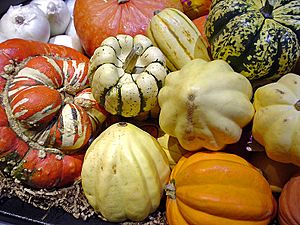Winter squash facts for kids
Winter squash is a type of vegetable that grows every year. It belongs to the Cucurbita plant family, which also includes other kinds of squash. Unlike summer squash, winter squash is picked when it's fully grown. At this point, its seeds are mature, and its skin becomes very hard. This tough skin helps most types of winter squash stay fresh for a long time, even through the cold winter months!
You usually cook winter squash before you eat it. Also, you typically don't eat the hard skin, which is different from how you might eat summer squash. In countries like New Zealand and Australia, people often use the word "pumpkin" to talk about what others call "winter squash."
Contents
Growing and Harvesting Winter Squash
Squash plants don't like cold weather. Their seeds won't sprout if the soil is too chilly. Winter squash seeds grow best when the soil is warm, about 21 to 35 degrees Celsius (70 to 95 degrees Fahrenheit). The warmer end of this range is even better!
You can pick winter squash when its color is deep and solid, and its skin feels very hard. In the Northern Hemisphere, most winter squash is ready to harvest in September or October. It's important to pick them before any really cold frosts arrive.
Why Winter Squash is Good for You
Winter squash is a healthy food choice! It's low in calories and packed with good things your body needs.
| Nutritional value per 100 g (3.5 oz) | |
|---|---|
|
8.59g
|
|
| Sugars | 2.2 g |
| Dietary fiber | 1.5g |
|
0.13 g
|
|
|
Protein
|
0.95 g
|
| Vitamins | Quantity
%DV†
|
| Vitamin A equiv.
beta-Carotene
lutein zeaxanthin
|
9%
68 μg
8%
820 μg38 μg
|
| Thiamine (B1) |
3%
0.04 mg |
| Riboflavin (B2) |
5%
0.062 mg |
| Niacin (B3) |
3%
0.5 mg |
| Pantothenic acid (B5) |
4%
0.188 mg |
| Vitamin B6 |
12%
0.156 mg |
| Folate (B9) |
6%
24 μg |
| Vitamin C |
15%
12.3 mg |
| Minerals | Quantity
%DV†
|
| Calcium |
3%
28 mg |
| Iron |
4%
0.58 mg |
| Magnesium |
4%
15 mg |
| Manganese |
8%
0.164 mg |
| Phosphorus |
3%
24 mg |
| Potassium |
12%
350 mg |
|
Link to USDA Database entry
|
|
| †Percentages estimated using US recommendations for adults. | |
It's an excellent source of vitamin A, which is good for your eyes and immune system. It also gives you lots of vitamin C, potassium, and dietary fiber. These help your body stay strong and healthy. Winter squash also provides manganese, folate, and some omega-3 fatty acids.
You'll also find smaller amounts of iron and beta-carotene in winter squash. Beta-carotene is what gives many squashes their orange color. The darker the squash's skin, the more beta-carotene it usually has!
Different Kinds of Winter Squash
There are many different types of winter squash, each with its own unique shape, color, and taste! Here are some common groups and examples:
Cucurbita maxima
This group includes some very large squashes.
- Atlantic Giant (known for being huge!)
- Banana squash
- Hubbard squash
- Kabocha (sometimes called "Hokkaido squash")
- Red kuri squash
Cucurbita moschata
These squashes often have a sweet, nutty flavor.

- Butternut squash
- Calabaza
- Long Island cheese pumpkin
Cucurbita pepo
This group has many popular and well-known squashes.
- Acorn squash
- Delicata squash
- Spaghetti squash
- Sweet dumpling squash



